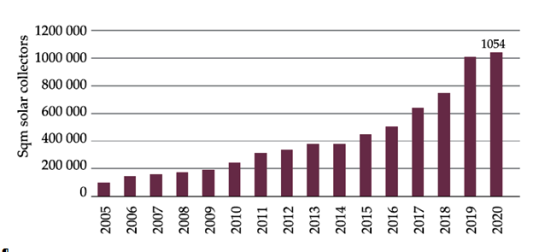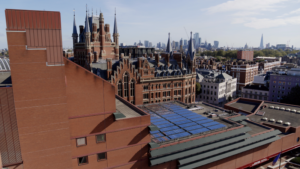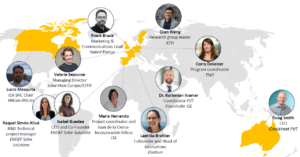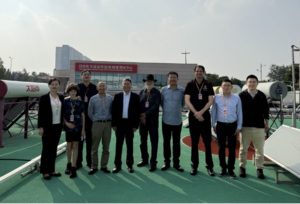
Lebanon: On Track for 2020 Square-Metre Target of 1 Million
 Lebanon seems to be one of only a handful of countries that are on track for meeting their solar thermal targets. The market statistics from the Lebanese Centre for Energy Conservation (LCEC) show around 250,000 m² of collector area were installed between 2009 and 2014, which exceeded the government’s aim of 190,000 m² for the same period. The second target set in 2009 – a collector area of 1 million m² by 2020 – is just as realistic, LCEC confirmed in its recently published National Renewable Energy Action Plan (NREAP) for the Republic of Lebanon 2016-2020 (see the attached document). The chart shows an estimated market increase of 600,000 m² between 2016 and 2020. The LCEC researchers and authors of Lebanon’s second NREAP also underline the importance of continuing the country’s financing mechanism.
Lebanon seems to be one of only a handful of countries that are on track for meeting their solar thermal targets. The market statistics from the Lebanese Centre for Energy Conservation (LCEC) show around 250,000 m² of collector area were installed between 2009 and 2014, which exceeded the government’s aim of 190,000 m² for the same period. The second target set in 2009 – a collector area of 1 million m² by 2020 – is just as realistic, LCEC confirmed in its recently published National Renewable Energy Action Plan (NREAP) for the Republic of Lebanon 2016-2020 (see the attached document). The chart shows an estimated market increase of 600,000 m² between 2016 and 2020. The LCEC researchers and authors of Lebanon’s second NREAP also underline the importance of continuing the country’s financing mechanism.Figure: Chart from NREAP, p. 87
Since October 2010, buyers of solar water heaters have been able to apply for a five-year zero-interest loan at one of the five banks operating in the country. This loan scheme is part of a financing mechanism called National Energy Efficiency and Renewable Energy Action (NEEREA). If an installer is LCEC-qualified, the owner of a residential SWH system will also be eligible for a grant of USD 200 from the Ministry of Energy and Water.
In 2015, the banks received 1,517 loan applications, of which 1,407 came from LCEC-qualified businesses. The number of loans and grants paid in 2016 will be available in the middle of this year, together with LCEC’s annual market statistics on the collector area newly installed across the country.
This is how the NREAP authors describe the path to 1 million: “The culture of SWH installations is well established in Lebanon. To keep boosting the market, the NEEREA financing mechanism will need to continue. On the other hand, LCEC will be launching special initiatives regularly to give the market additional boosts, especially through the USD 200 subsidy programme.”
Solar heat becomes essential part of national renewable strategy
An important step towards guaranteeing the programme’s future is the continued commitment of the central bank of Lebanon to NEEREA, one of its most successful financing mechanisms. The second driver is the Ministry of Energy and Water, which has already allocated the budget required for the 2020 extension. Other market impulses may come from a new mandate to use solar water heaters in newbuilds. LCEC believes that this ordinance could lead to around 10 % more area per year between 2016 and 2020.
Additionally, the NREAP 2016-2020 document goes into more detail about the 2020 targets than the previous one did in 2009. Back then, it simply read: “12 % of renewable energies by 2020.” This time, the wording is more precise: “The amount of energy produced by renewable energy sources in 2020 should be equal to 12 % (767 ktoe) of the total amount of energy needed for electricity and heating demand in the country.” Solar water heating could contribute 19 % to this target and save 148 ktoe – a USD 192 million market between 2015 and 2020 and one that, as the authors of the NREAP 2016-2020 write, would be “completely supplied by the private sector.”
Websites of organisations mentioned in this article:


